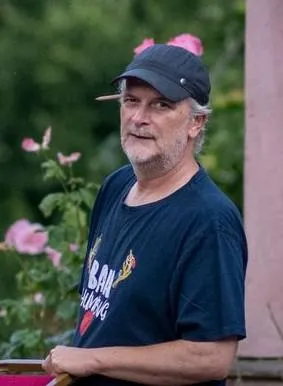ASHA's Values
Connection
We believe in the power of bringing people together across all boundaries, cultural and spiritual. Gatherings at ASHA are an opportunity to build bridges and understanding.
Sustainability
Our commitment to the earth runs deep. From our organic gardens to our eco-friendly practices, we honor our responsibility as stewards of this beautiful land in the Forest of Dean.
Compassion
At the heart of everything we do is love and care. We hold space for joy and sorrow, celebration and reflection, ensuring every moment is treated with the reverence it deserves.
ASHA's Founder: Zerbanoo Gifford
Author, human rights campaigner and founder of the ASHA Centre. Zerbanoo Gifford holds the International Woman of the Year Award 2006 for her humanitarian work, which spans over fifty-five years of grassroots and global activism.
Zerbanoo has written widely on historical, social and political themes and made two documentaries on street children. She was chosen, along with Bishop Trevor Huddleston, to present the ‘People's Petition’ to Mrs Thatcher at 10 Downing Street, calling for the release of Mandela.
In 1989, Zerbanoo received the Nehru Centenary Award for her work championing the rights of women, children and minorities. A pioneer in British politics. In 1982, she made history and was elected a Councillor in Harrow and was the first global majority woman to stand for parliament. Zerbanoo chaired the Commission ‘Looking into ethnic minority involvement in British Life’ and was an advisor to the British Home Secretary on race relations and equality.
A director of Anti-Slavery International (the oldest Human Rights organisation in the world), she was awarded the Freedom of the City of Lincoln, Nebraska, for combating modern slavery and racism.

In 2007, Zerbanoo received the International Splendour Award in Hollywood for her lifetime achievements in the field of equality, human rights and interfaith understanding. In 2010, to celebrate the 90th Anniversary of American Suffrage, she was honoured by the Sewall-Belmont Museum in Washington, DC in an exhibition commemorating key global women who have advanced women’s rights.
Zerbanoo has been the President of the World Zoroastrian Organisation. In 2022, the World Zoroastrian Congress presented Zerbanoo with the Global Entrepreneur Award, where she launched www.zasha.info as a celebration of the diversity and talents of Zoroastrian women worldwide. In 2025, Zerbanoo became the only woman to be made one of the select Honorary members of the World Zarathusthi Chamber of Commerce (WZCC).
Zerbanoo is one of the few women to be inaugurated into the ancient order of the Knights of the Round Table.
Author of seven books, including ‘Thomas Clarkson and the Campaign Against Slavery’, and ‘Dadabhai Naoroji, Britain’s First Asian M.P.’ ‘Confessions to a Serial Womaniser – Secrets of the Worlds Inspirational Women’. It highlights the lives of 300 exceptional women from 60 countries, who she interviewed and was awarded a ‘NESTA (National Endowment of Science Technology and Arts) Fellowship’. ‘Z- A o f Zoroastrianism’, Zerbanoo’s biography ‘An Uncensored Life’ by Farida Master is published by Harper Collins.
Patrons, Trustees & Team

Adrian Locher
Senior Trustee & Strategic Advisor
Adrian brings decades of experience in sustainable development and environmental stewardship.
Read More
Adrian Lochner has dedicated over 25 years to advancing sustainable practices across both corporate and non-profit sectors. His expertise in environmental policy and community development has been instrumental in shaping ASHA's commitment to ecological harmony. Adrian's vision for regenerative practices continues to guide our land management and facility development.

The Right Honourable Baroness Royall
Patron
A distinguished public servant and advocate for social justice and interfaith dialogue.
Read More
The Right Honourable Baroness Royall of Blaisdon brings her extensive experience in public service and commitment to social cohesion to ASHA Centre. Her work in promoting understanding between communities of different faiths and backgrounds aligns perfectly with ASHA's mission of bringing people together in harmony.

Matthew Williams
Director
Matthew oversees business operations, stewardship and ensures every event reflects ASHA's values of connection and care.
Read More
Matthew Williams has been instrumental in developing ASHA's business operational excellence since joining as Managing Director in 2024. His background in the arts, B2B strategic intelligence, marketing, event management and holistic psychotherapy, combined with his deep understanding of ASHA's mission, ensures that every gathering - from intimate ceremonies to large retreats - is held with the highest standards of care and attention to detail.

Steve Etter
Centre Manager
Steve's hands-on approach ensures our spaces and gardens are maintained to the highest standards.
Read More
Steve Etter's passion for facility management has transformed ASHA's grounds into the flourishing sanctuary visitors experience today. His meticulous care for our 4,000 roses and attention to every detail of our physical spaces creates the perfect environment for meaningful gatherings and personal reflection.
Experience the magic of ASHA
Whether you're planning a celebration, a retreat, or simply curious about our mission, we invite you to discover what makes ASHA special.

An international charity working for equality and empowerment in the fields of sustainable development, personal growth, the arts and interfaith, intercultural dialogue.
Quick Links
Contact
The ASHA Centre
Lower Spout Lane
Gloucestershire
GL17 0EA
+44 (0) 7468 165 098
Follow Us
© 2025 ASHA Centre. All rights reserved. Charity registered in England and Wales.
